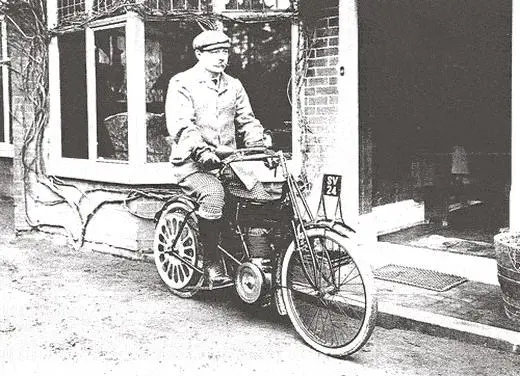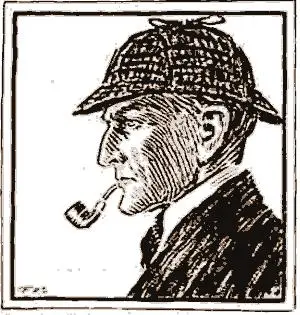This is a massive development, and quite unacceptable in my view." And Doyle's great-nephew Richard Doyle, reportedly 'upset', said "The family had been trying to come up with ways of buying it, but the price was so high we could not afford it. We just wish there was something we could do."
In March 2010 it was stated that the developer would accept £1.5 million for the property, but it was unclear six months later if the offer was still open at that price. Preservationists were frustrated when attempts to promote Undershaw into the top rank of protected buildings failed. A government report stated that the house was not architecturally notable, and that Sir Arthur Conan Doyle was not of the same standing as Jane Austen or Charles Dickens.
While the red brick house is less than an architectural marvel, it bears the imprint of Conan Doyle's character. Doors are doubled-hinged, to accommodate a large man with an energetic stride who couldn't stop to turn a knob or pull a door towards him. Stained-glass panels show the coats of arms of Mary Foley Doyle's venerable family, and doors are monogrammed with Conan Doyle's initials. Conan Doyle wrote both The Hound of the Baskervilles and The "Empty House" at Undershaw.
A developer first planned to convert the home into 13 apartments, but has compromised at four. Conservationists want the home listed as a Grade I English Heritage Property, which would preserve it as a single-family dwelling with some public access. But there are problems: the house spent many years as a hotel-restaurant, and has been abandoned since 2004. Vandals have left it open to the elements, and, according to recent reports, have destroyed some of the architectural features. The appropriate government agencies are assessing the application for historical preservation now. Undershaw might not survive the wait.
The Motorcycle
Conan Doyle claimed to be involved in the introduction of a device which has an “enormous future." In the 11th November 1913 issue of Cycling magazine, he stated that "autocycles" would soon be in use by the “hundred thousand” and would “give a boom to the cycle trade”. Nor would it interfere with the motor cycle trade for “the young fellow who loves power and speed will still prefer the motor cycle.”
He then goes onto suggest that dad (paterfamilias) can use his bike for business, mum (mater) can use hers for a spin on Saturday, and the boys can fit it out for a summer holiday. “ In a year or so they will be everywhere, they are cheap, effective and meet a popular want!”

Conan Doyle outside Undershaw on his ROC motorcycle. He helped finance the company in its early years (1904 to 1914)
* 1904 The Roc had a 3hp engine, free-engine clutch and magneto ignition.
* 1905 The engine was fitted with an outside flywheel on each side
. * 1908 The new model for that year was the 4hp Royal Military, with a long wheelbase, live rear-axle with clutch and two-speed gear.
* 1909 A new front-fork using C-springs appeared and engines were a 4hp single and a 5-6hp twin.
The Many Faces of Holmes
The original readers of the very first Holmes story, A Study in Scarlet, had to do with four lackluster illustrations by D.H. Friston, but, when the novella was published in book form, Holmes looked something like Arthur Conan Doyle's own father, Charles Altamont Doyle--and was, in fact, the elder Doyle's creation. The author's father created a series of vague line-drawings that unfortunately failed to capture the excitement of the text. He gave Sherlock Holmes his own features, including his scraggly beard. No record exists of his son's response.
When "A Scandal in Bohemia" was published in The Strand Magazine in 1891, readers were greeted with Sidney Paget's moody drawings, which represent Holmes as tall, handsome, and elegant, despite Conan Doyle's original description, according to which Holmes was extremely thin, with a large nose and small eyes set close together. Apparently Paget's younger brother Walter, whom the artist used as a model, was quite a handsome fellow. Years later, after his brother's death, Walter himself illustrated a few of Conan Doyle's stories in The Strand.
Conan Doyle soon grew attached to Sidney Paget's elegant vision of Holmes, and when he met the American actor William Gillette, who wanted to play Holmes on the stage, he felt that his creation had come to life.

William Gillette as Holmes,
drawn from life by Frederic Dorr Steele
Holmes is balding in J. Frank Wiles's illustration from The Valley of Fear. Others, such as the American illustrator Frederic Dorr Steele, who based his Holmes on William Gillette, also created a compelling vision of the detective and his world. Holmes usually remained tall and thin, but not always young or handsome.
Holmes and Watson were well-represented on the radio, too. See "The Sherlock Society of London" website for a list of radio plays (including some stories not written by Conan Doyle) that can be downloaded in MP3 format.
Holmes in Film
During Conan Doyle's lifetime, silent film versions of the Sherlock Holmes stories were made in England and the U.S. In the U.S, John Barrymore played Holmes in a film based on one of Gillette's stage plays, and British actor Ellie Norwood played Holmes in 47 silent films between 1920 and 1923.
1 comment